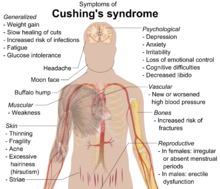Diet-induced obesity model
Users of such models must take into account the duration and type of diet (e.g. hydrated gels vs. dry pellets) as well as the environmental conditions and age of the animals, as each may promote different bodyweights, fat percentages, or behaviors.
[4] However, while many insights into the control of obesity have come from experiments since its introduction in 1949, the use of animal models does restrict our ability to extrapolate findings to humans.
Additionally, samples of low-income women and children were also shown to have higher rates of obesity because of stress.
Studies on the relationship between infectious agents and weight gain show that certain species of gut flora can affect metabolic processes.
[19] Such limitations can be divided into three broad categories—biological, dietary and experimental differences—factors including, but not limited to, the genetic makeup of the species or strain, the environment in which the specimen is held (temperature, light, number of animals), age, sex, the duration of the experiment, and the texture or type of rations fed to the animals.
[3] Numerous sources of biological variation arise in rodents before translating results to humans is even considered.
[24] Even within a single strain, large amounts of variation in the phenotype can be seen, despite each mouse having identical genetic backgrounds, which greatly hinders reproducibility.
[25] When functional genomics is applied, few commonalities between the gene expression of DIO vs control rodents and obese vs non-obese humans are found.
[1][25] This is particularly true in the case of glucose regulation, which greatly hinders the ability to apply the results of the DIO model to humans, especially for drug development.
In fact, recent studies prefer to use purified ingredients to exams the effect of each dietary on rodents' metabolism and their phenotype.
However, the variation in the results of those models has caused the difficulties to interpret and find the relation to human case.
[19] In addition to protein, Fructose, a carbohydrate, has impact on fat deposition, plasma insulin, leptin, thyroid, estradiol, and corticosterone levels, lipogenesis, and lipolysis in the adipose tissue of the rat.
[19] Intra and Inter Laboratories results can differ due to variation in the experimental factors such as the protocol used, housing, temperature, light/dark cycle and the duration of study.
[33] The psychological effects can introduce further discrepancy in the studies that makes it difficult to render proper data and further hinders the possibility of recapitulating such experiments in humans.
The cause of type 2 diabetes mellitus in humans are far more complicated than the sole consumption of a high fat diet.
The mental, emotional and cultural factors along with insulin resistance and hyperphagia are known to increase the occurrence of type 2 diabetes in humans.
[19] However, type 2 diabetes in model organisms are introduced via surgery of partial or whole pancreas, or using chemicals such as streptozotocin.
It can also interfere with other cell signalling pathways as well as affects the content of certain isozymes in organs like liver, brain and kidneys.
[35] The lack of proper representation of the undertaking of the experiment can introduce type 2 diabetes, but fails to reflect the mechanism through which these disease takes place in humans.
Mice are used by scientists as diet-induced obesity models in experiments because they have mammalian physiological systems similar to those in humans.
In studies with A. chevrieri, scientists found that even if metabolism is controlled by day length, the mice could still gain weight with a high-fat diet.
Commonly used in medical research, rats were specifically chosen to study the diet-induced obesity model because of the features that they share with humans.
[44] In this experiment, it was found that a high-fat diet caused insulin resistance, contributing to cardiovascular disease, cancer, and type 2 diabetes.
The specific fatty foods used in the diets vary across studies, ranging from Crisco to lard to palm oil.
Depression and long-term stress are also reported mechanisms contributing to obesity via increased food intake.





